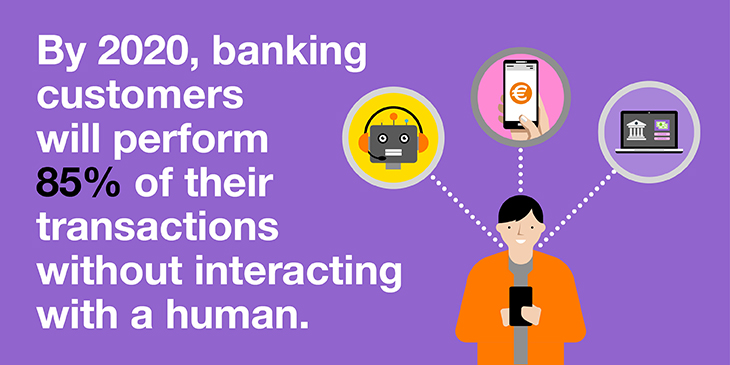Transforming a traditional financial institution into an agile, digital business is no small feat. And, as with all things digital transformation, it is about much more than the technology itself. Infrastructure and legacy processes must change of course, but banks and insurance companies also need to address their whole view of their customer – meaning company culture must change, too. It might seem daunting, but there really is no alternative.
Starting point? Understand your customer
As in any industry, understanding your customers' motivations and demands is the best place to start. In its "Performance Against Customer Expectations" (PACE) report, financial software specialist FIS found that the traditional bank branch is now effectively carried around in the customer's pocket. Three-quarters of all financial interactions are now digital, with Millennials at the forefront of this shift, and digital self service is a high priority for banking customers under the age of 53. Mobile banking is used more than any other delivery channel, including laptops, PCs, ATMs and high street branches. Consumers very much seem to want digitized financial services.
What specific digital technologies are changing the financial landscape?
With customers now expecting a mobile experience that is tailored around their lifestyles, it is important for financial companies to address their demands and expectations specifically. Some digital technologies that have already gained footholds in other industries seem certain to increase their roles in the digital transformation of traditional banking services.
1. Chatbots. Consumers are already using chatbots in numerous industries, and while they have historically tended to divide people, they are gaining traction fast in financial services. The Aspect Consumer Experience Index report found that at the start of 2017, half of consumers said they prefer to conduct all customer service interactions via text, chat or messaging, while 44 percent said they would prefer to use a chatbot to do so. Gartner has predicted that by 2020, customers will perform 85 percent of their transactions without interacting with a human. In the meantime, financial companies must find the right balance that delivers the necessary degree of chatbot-enabled self service that the customer wants, with the ability to seamlessly pass incoming customer calls to a human agent when necessary.

2. Video calling. Being able to chat by video with an agent can give banks quick customer experience wins at the push of a button on the company's website or within its app. There is a challenge in that financial companies are trying to move away from voice calling as a cost reduction measure, but video calling can give a competitive advantage: over half of banks surveyed in the recent How Consumer Demand is Shaping the Future of Video Calling for Enterprises report by Sinch said video calling is most useful for customer service and resolving support issues. Big name financial institutions already using video calling as part of their omnichannel communications strategy include Barclays, Santander, Wells Fargo and Standard Chartered, citing it as a highly personalized, real-time service that positively impacts the customer experience while also ensuring that sensitive information remains secure.
3. Robo-advisors. Global giants like Morgan Stanley, Deutsche Bank and Wells Fargo all announced digital advice products in 2017, with Morgan Stanley citing robo-advisors as being particularly useful in supporting small accounts at scale, enabling them to reach out to customers before they have enough assets to meet full-service advice minimums. Robo-advice is gaining traction with customers, with Accenture finding that the clear majority of people are now happy to receive exclusively robo-generated advice for financial products, with which type of bank account to open ranking highest at 71 percent. With that in mind, Orange recently introduced a Wealth Management as a Service offering for financial institutions, based on robo-advisor technology.
4. Digital signatures. This is a huge growth area and a technology that financial companies must offer if they want to drive an enhanced experience for their customers. Digital signatures help customers save time by speeding up front-end operations and simple transaction procedures and are now accepted as the most advanced, secure way to obtain a signature. They help increase transparency and efficiency in general, including reducing overhead, and have been estimated to help companies save an average of $20 per document and reduce turnaround times by as much as 80 percent. According to Forrester, the market for digital signature solutions will grow at 60 percent CAGR from 2015 to 2020 and impact 90 million transactions across that period. Digital signatures are set to play an increasingly important part in how financial companies improve their services and enhance customer experience.
Leveraging digital to drive the customer experience
Customer experience is a powerful driver for commercial success, and digital tools like those listed above are essentials for financial companies to thrive. But all of this is not to say that banks can neglect the human touch: customers want digital tools and services that give them greater control and reduce their time and hassle, but banks must acknowledge the need for the human factor when necessary. It is about finding the right mix.
By implementing digital tools and driving an omnichannel communications approach, financial companies can help customers engage with them when, where and on whatever device they choose, and the company should also focus on continuous engagement throughout the customer journey. Think about customer experience first and always.
The revolution reshaping the financial services industry is creating countless opportunities for financial institutions to reinvent their business models through innovation. Discover our IT services dedicated to banks and financial services and how we can help you improve your customer experience.

I’ve been writing about technology for around 15 years and today focus mainly on all things telecoms - next generation networks, mobile, cloud computing and plenty more. For Futurity Media I am based in the Asia-Pacific region and keep a close eye on all things tech happening in that exciting part of the world.